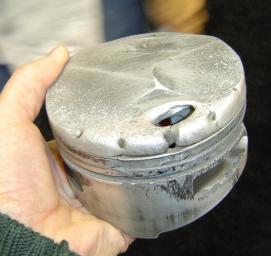Forum Discussion
BenK
Jun 05, 2016Explorer
Just checked to see that the portal bad word filters ****'d mine...
Back off the timing instead of re-tard the timing (hope the dash fools the computer)
The second one that was ****'d is a mystery, as that was a.d.v.a.n.c.e is dialed
in.
Comment that with the need to protect themselves from warranty costs due to both
the ever increasing power that can twist things into pretzels easily...and that
less and less folks actually know or wrench (hard knock schooling) themselves...that
they have to have more and more computers that are highly integrated into the
system.
From experience dealing with several auto-OEM design teams...that
they do NOT understand real time software control...nor do they
(generalization...the must be some...) understand real time
master/slave hierarchical control philosophy
Most think real time is to place the interrupt into the queue...real time for
this kind of application is to place that interrupt flag into level cache queue
Or microsecond/milliseconds to respond to whatever that flag was for
To the PM asking what is the coil rise time...it is the time the coil will recharge
after dumping to the spark plug
The FETs can fire in microseconds and my expectation of a performance coil is
to have it recharge in the order of 3 microseconds...but that is for a high
quality (mainly the lamination material) coil (transformer)...
And to the what is 'carbon build up' and 'glow'...it is in the CC
(combustion chamber) that has mineral/carbon build up.
Both increase the ratio a bit and to 'glow' hot enough to ignite the
charge without any spark. As the PSI increases, the higher the tendency
for that carbon/mineral deposit to glow hot enough to ignite
As for what is knock, it is where the charge ignites some other place
from the spark plug's electrical arc. So both ignitions will then have
a shock wave merging on each other to create a much larger PSI point
That is like a ~1,800*F flame front hitting another similar to then
cause HUGE PSI shock on all surfaces inside the CC...think of a sledge
hammer smacking the CC chamber surfaces
Betcha Turtle even has some of these busted parts sitting on his work
desk...most of us boy racers have them...the 'ex' tossed out mine... :M
But I see them all the time at the speed shop counters... :B
Both melt and break the CC surfaces....here are some pics of that



This is a good one showing the other ignition flame front hitting the
spark plug ignition fame front...and ICE's 'burn' during the power
stroke...it is *NOT* an explosion...of which the knock/pre-ignition
is...made worse when the two flame fronts smack into each other...

Back off the timing instead of re-tard the timing (hope the dash fools the computer)
The second one that was ****'d is a mystery, as that was a.d.v.a.n.c.e is dialed
in.
Comment that with the need to protect themselves from warranty costs due to both
the ever increasing power that can twist things into pretzels easily...and that
less and less folks actually know or wrench (hard knock schooling) themselves...that
they have to have more and more computers that are highly integrated into the
system.
From experience dealing with several auto-OEM design teams...that
they do NOT understand real time software control...nor do they
(generalization...the must be some...) understand real time
master/slave hierarchical control philosophy
Most think real time is to place the interrupt into the queue...real time for
this kind of application is to place that interrupt flag into level cache queue
Or microsecond/milliseconds to respond to whatever that flag was for
To the PM asking what is the coil rise time...it is the time the coil will recharge
after dumping to the spark plug
The FETs can fire in microseconds and my expectation of a performance coil is
to have it recharge in the order of 3 microseconds...but that is for a high
quality (mainly the lamination material) coil (transformer)...
And to the what is 'carbon build up' and 'glow'...it is in the CC
(combustion chamber) that has mineral/carbon build up.
Both increase the ratio a bit and to 'glow' hot enough to ignite the
charge without any spark. As the PSI increases, the higher the tendency
for that carbon/mineral deposit to glow hot enough to ignite
As for what is knock, it is where the charge ignites some other place
from the spark plug's electrical arc. So both ignitions will then have
a shock wave merging on each other to create a much larger PSI point
That is like a ~1,800*F flame front hitting another similar to then
cause HUGE PSI shock on all surfaces inside the CC...think of a sledge
hammer smacking the CC chamber surfaces
Betcha Turtle even has some of these busted parts sitting on his work
desk...most of us boy racers have them...the 'ex' tossed out mine... :M
But I see them all the time at the speed shop counters... :B
Both melt and break the CC surfaces....here are some pics of that


This is a good one showing the other ignition flame front hitting the
spark plug ignition fame front...and ICE's 'burn' during the power
stroke...it is *NOT* an explosion...of which the knock/pre-ignition
is...made worse when the two flame fronts smack into each other...

About RV Tips & Tricks
Looking for advice before your next adventure? Look no further.25,179 PostsLatest Activity: Dec 05, 2025